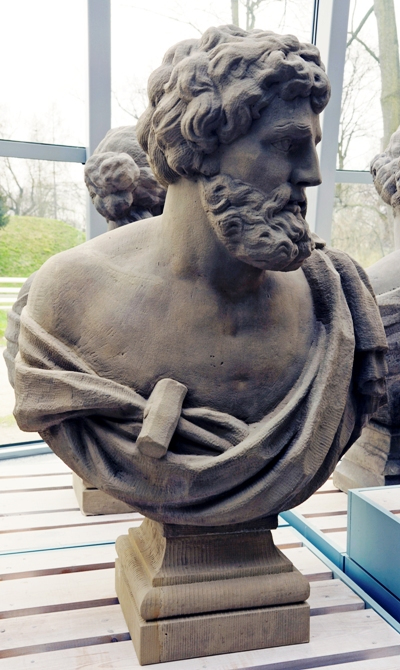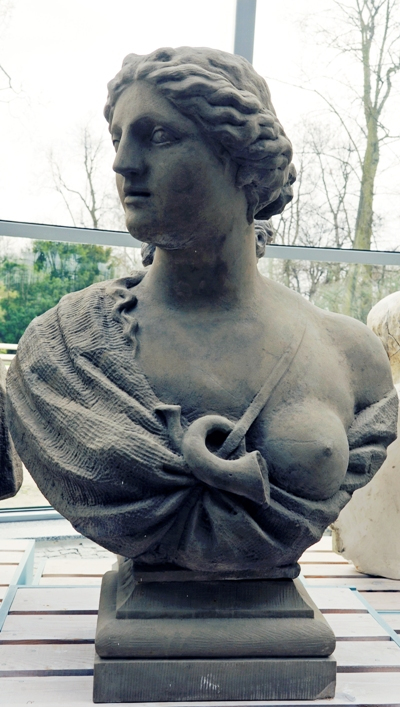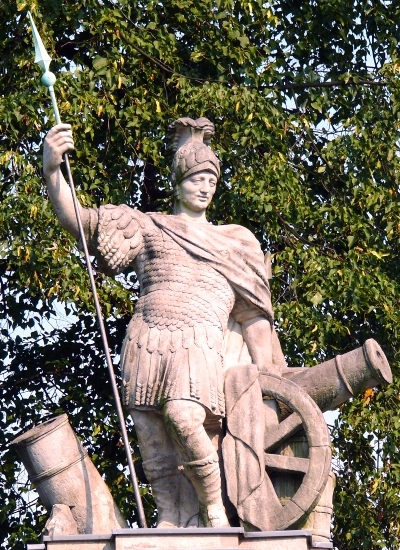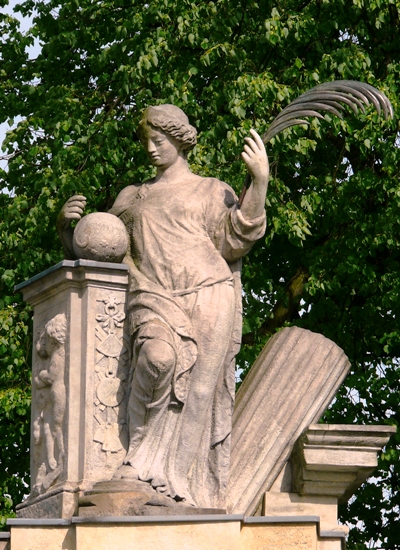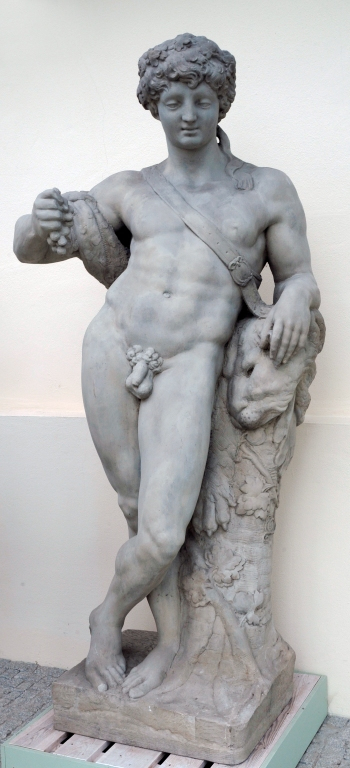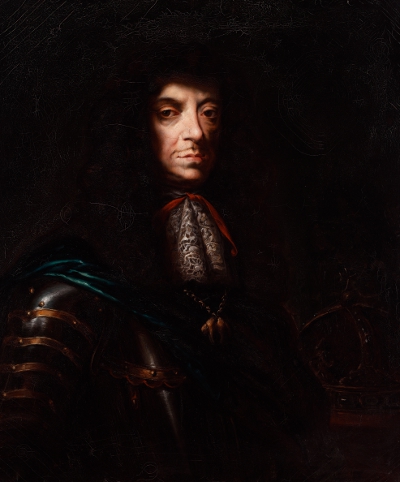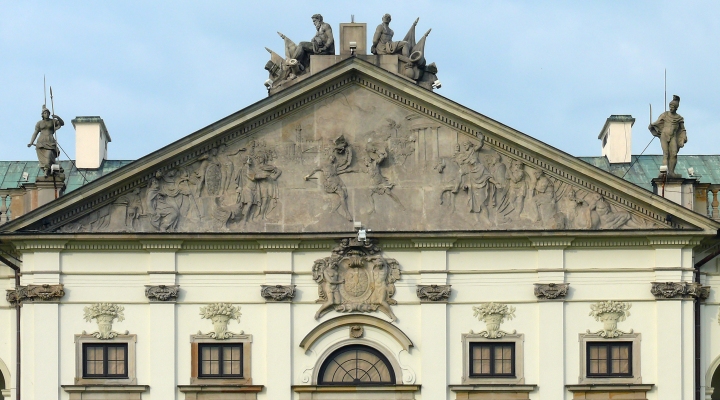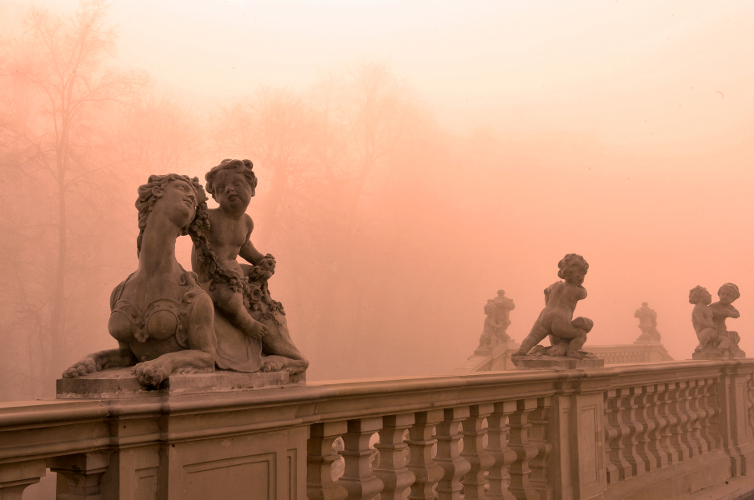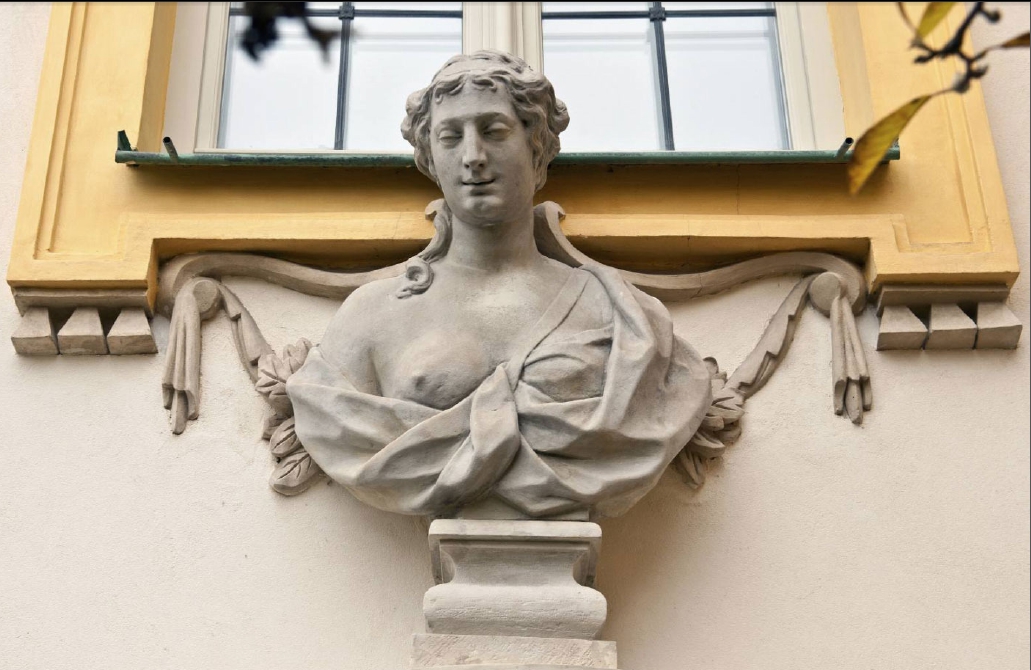Stephan Schwaner (registered 1682–92)
The time and location of Schwaner’s birth and death are unknown, and biographical information about himself and his family are absent even in seventeenth-century municipal and parish records for Gdańsk and Warsaw. In light of archival materials and the collected oeuvre, the artist should be considered the main sculptor responsible for the figural decoration in the royal villa at Wilanów during its expansion in 1681–92. Schwaner also bore the official title of royal sculptor. Mariusz Karpowicz’s findings from the 1970s and 1980s place Schwaner next to Andreas Schlüter the Younger (1660–1714) as another representative of the so-called Gallic tendency in Warsaw sculpture of the final quarter of the seventeenth century to come from Gdańsk.
Schwaner’s activities at Wilanów were reconstructed by way of letters between Agostino Vincenzo Locci, tasked with supervising the construction works and successive stages of modernisation and decorating, and the King. The first mention of the sculptor to whom Locci delegated the most important sculptural tasks with the King’s approval (shared with another sculptor, known as Hans) comes from 12 September 1681. On that day, the King’s intendant noted the appearance in Warsaw of an unknown artist, who found employment at the workshop of a sculptor by the name of Nowotny. Prior to 17 October, most likely the same sculptor — described as statuarius — was invited to Yavoriv (where the King and his court were saying at the time) to present his skills on Podolian alabaster, among other materials. On 24 October, Locci wrote to the King asking for the artist in question to be sent to Wilanów to chisel capitals from Szydłowiec sandstone throughout the coming Winter.
The sculptor arrived to Wilanów before 31 October and was tasked with preparing a minor-scale sculptural group in the manner of putti fiamminghi (a sculptural modello), in which — according to the consonant opinion of Locci, other courtiers and a sculptor from Gdańsk known as Hans also employed at the site — he masterfully captured the face of Sobieski’s youngest son, the one-and-a-half year old Konstanty Władysław. In a letter dated 7 November, Locci planned to employ the sculptor in making statues of gods and goddesses or muses, intended for placement at the balustrades on the vault towers of the expanded villa. After that date, both aforementioned sculptors left for Gdańsk to return on 24 November; within the following four days, Locci tasked Schwaner with sculpting the figure of Apollo for the axis of the garden façade, and Hans with preparing a capital for a column or a pilaster.
The only archival record directly involving Schwaner is found in two letters by Locci, dated 7 September and 13 November 1686 and discussing the artist’s progress in applying stucco by hand in the arcades of the side galleries and the attic of the mezzanine of the main body of the Wilanów residence as part of the redecoration of the palace. Locci’s information concerning the scenes of Triumph (in the arcade of the central bay of the triumphal arc on the frontal façade of the South Gallery; Schwaner prepared a modello of the relief for the King before 7 August) and the Royal Coronation (in the right bay of the main body, completed after 31 November) allowed for both sets of works — the first composed of six, the second of eight figural reliefs — to be attributed to the sculptor. The triumphal-allegorical cycle is composed of, in order: Hora, Aurora or Zephyr and Flora, Arion (in the North Gallery), and The Picking of Laurel and Palms, The Triumphal Parade of Jan III, and the March of the Turkish Prisoners of War (in the South Gallery). The martial-political cycle comprises: Excursion Toward the Tatar Squadrons (1672), The Battle of Khotyn (11 November 1673), The Battle of Lysynitchi/Lviv (24 August 1675), Election (21 May 1674), Coronation Parade in Cracow (30 January 1676), Peace at Zhuravno (17 October 1676), The Battle of Vienna (12 September 1683), and The Battle of Párkány (7–9 October 1683). Some of the compositions rely on modern etchings by François Perrier, Joachim van Sandrart, and Pietro Santi Bartoli, documenting the figural decorations of the Roman Trajan’s Column, commemorating the triumphs of Emperor Traianus over the Dacians (AD 113) and the ancient arc of triumph dedicated to that ruler at Benevento (AD 114). Due to the extensive damage to all aforementioned etchings and deeply intrusive restoration efforts in 1922–9, 1955–64, and 2004–10, none of these reliefs can be seriously considered as a basis for comparative analyses.
At the same time, in letters dated 31 July and 13 November, Locci relayed to the King news of the completion of figural decorations for both tympanums of the main body — which included the roughly cut stone figures and trophies covered with a preserving coat by the stuccoworkers, removed in 1691 during expansion works in the Grand Hall (called Banqueting Hall) — and then on the placement of two stone figures on the corners of attics on projections of the main body on the side of the Grand Courtyard. Secondary sources unanimously contend that the works in question were the seven statues of gods and goddesses currently held in the Lapidarium of the Museum of King Jan III’s Palace at Wilanów, listed in order from the left according to late-eighteenth century iconography: Diana, Venus, Juno/Iris, and Flora (in the northern projection), and Bacchus, Antinous/Apollo, and Mars (in the southern projection). In a letter from Rakowiec on 3 March 1725 to Duchess Elżbieta Sieniawska née Lubomirska, Locci recounted: ‘the statues at the Wilanów Palace fall into two categories: the ones that stand below, that is, on the courtyard gallery, were made by the late Schwaner, sculptor of His Royal Highness, who helped the masons place them …’. Later on in the same letter, Locci also stressed that it was Schwaner along with his assistants at Wilanów, the masons and stuccoist Antonio (Perti), who in 1692 placed the eight sandstone figures representing the Muses — ordered in 1686 from Amsterdam, from the workshop of Artus Quellinus the Younger in Antwerp — on the attic of the recently completed Banqueting Hall. Meanwhile, Locci’s letter of 7 January 1687 seems to suggest that the sculptor also made the lost statue of Pallas Athena which used to sit atop the Western (frontal) tympanum of the main body of the villa, later replaced by the white marble statue ordered from the Amsterdam workshop of Bartholomeus Eggers.
The aforementioned figural works at Wilanów, made in sandstone and stucco, were attributed to Schwaner in archival sources, enabling the attribution of other similar works produced during the subsequent stages of the extension of the residence in 1686–7 and 1691–2. Marks of his chisel have been duly found on a pair of figures representing a reclining Mars (alternatively a Sarmatian Mars, War, Strength, or Valour) and the Triumphant Peace (alternatively Peace, Might, Knowledge, Venus/Urania, or Victorious Venus) on the pillars of the entrance gate (dated to the 1690s), as well as a pair of depictions of the Eagle of the Commonwealth and the Pahonia of the Great Duchy of Lithuania, modelled by hand in high relief, with metal plates applied bearing the coat of arms of the King (Janina), on the eastern walls of the corner cabinets of the King and the Queen on the side of the garden. Based on clear formal and stylistic analogies with Schwaner’s aforementioned full body figures of ancient deities, one should also attribute to him a complex of eighteen sandstone busts of mythological goddesses and gods found at Wilanów — among others, Jove and Juno, Poseidon and Amphitrite, Hades, Apollo and Diana, Vulcan, Minerva, Ceres, Iris and Flora — positioned in pairs on the balustrades of the garden façade of both galleries in the villa. The entire complex of 45 figures, busts, and reliefs in stone and stucco constitutes the most significant part of the figural décor of the Wilanów villa produced during the reign of Jan III.
Thanks to Locci’s correspondence with Jan III, it is also known that around 7 August 1686 Schwaner was commissioned by the King to prepare modellos of two statues, of Saint Joseph and Saint Teresa of Ávila — most likely based on drawn designs by the main court painter, Jerzy Eleuter Siemiginowski — planned for placement at the stone façade of the church of Discalced Carmelite Sisters in Lviv, which were subsequently carved in full scale for 200 Polish Złotys in 1688. Today, Schwaner’s chisel is only believed to have been responsible for the figure of Saint Joseph, with the section including the heads deeply remade after 1945; the statue of Saint Teresa most likely originated in the early eighteenth century.
So far, no works created by Schwaner beyond the sphere of Jan III’s artistic initiatives have been identified. However, in early 1682, a Gdańsk-born stonemason called Stefan found employment in Warsaw at the behest of Jan Dobrogost Krasiński, Grand Royal Referendary and Starosta of Warsaw, who offered the former a high commission of 1,000 Polish Złotys for carving six figures for two tympanums in his palace at Długa Street, which was being built at the time from a design by Tielman van Gameren. Until 1683, the sculptor collected payments to the amount of 1,140 Polish Złotys for the work, while also receiving a total of 350 Złotys for carving pedestals and plates for a gallery and sculptural decorations of the casing of an unspecified fireplace at the piano nobile. Maintained until September 1944 and recorded photographically, the sculptures — replaced today by modern copies — represented in order: Marcus Valerius Corvinus surrounded by prisoners of war and trophies, with Pallas Athena and Mars (on the eastern, frontal tympanum), and another figure of Marcus Valerius Corvinus (?) in the same setting, with Victoria and Pallas Athena (?) (on the western tympanum). The figures bear a striking resemblance to analogously posed ancient deities at the villa and gate at Wilanów. Thus far, studies have disregarded archival records, mistakenly ascribing the aforementioned works — after Tadeusz Mańkowski and Alfred Schellenberg — to Andreas Schlütter the Younger, who was also employed, along with assistants, on the same project, but only in 1689–93.
Due to the absence of any other biographical information about Schwaner, his hypothetical Gdańsk background has to be treated with the utmost caution. It is not unlikely that Gdańsk was merely a stop along a longer route for the artist, and his employment at the royal court, first to Jaworów, and then to Wilanów, may have been the result of Locci’s lobbying, motivated by the latter’s need for a suitably well-versed specialist capable of taking up the prestigious post of a court sculptor.
Schwaner was a comprehensively educated sculptor who used drawn studies, bozzetos and modellos as part of the designing process; he also had experience in cabinet sculpture in alabaster and stucco. When creating large-scale figural sculptures in stone — the main object of royal commissions for Wilanów, Lviv, and Warsaw — he deftly implemented patterns derived from a host of graphic renderings of ancient Roman statues, authored mainly by Vaccaro, Perrier, Bartolo, and von Sandrart, as well as ancient originals (observed most likely in the Netherlands or the northern countries of the German Reich, by way of modern copies imported from Italy), compiling and embellishing classical forms with modern elements drawn from the well-known Flemish and Dutch sculpture of mid-seventeenth century. A formal and stylistic analysis of Schwaner’s works in Wilanów and Warsaw proved that personal experience and drawings allowed him to acquaint himself primarily with the most famous works of Artus Quellinus the Elder and Bartholomeus Eggers from 1650s–80s, found in Amsterdam’s town hall; he also knew the leading works of Flemish and Dutch sculpture at major churches of Amsterdam, the Hague, Rotterdam, and Antwerp, and in the residences of the Great Elector of Brandenburg in Berlin, Oranienburg, and Potsdam. One cannot also exclude the possibility that Schwaner drew inspiration from early works of representatives of the classical tendency in Dutch sculpture of the final quarter of the seventeenth century in Amsterdam, the Hague, and Gouda.
At the current stage of research, Schwaner has to be identified as the major proponent of the classical Flemish tendency in Warsaw sculpture of the 1680s, up until the arrival — no later than 1689 — of the similarly educated, but even more talented Andreas Schlütter the Younger. A symptomatic disappearance of Schwaner’s name after 1692 coincides with the King’s decision, taken a while before 21 September 1692, to entrust the design and production of figural decorations of four gravestones of the Sobieski and Daniłowicz families in Zhovkva (made in English alabaster) to Schlütter, with Locci again acting as an intermediary. It is hard to decide whether the change in the status of the royal sculptor was the result of his demise or departure from the capital, or whether it grew out from a conscious decision by the King to spread responsibility for works at Wilanów and Zhovkva between the two artists.
Translation: Antoni Górny
